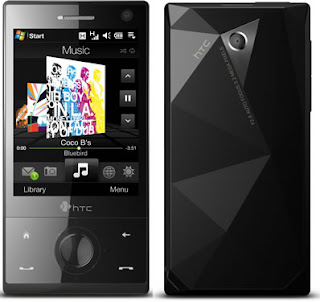However, its not coming first to Sprint (as many of us hoped/thought), or even to the US for that matter... No, the first CDMA Touch Diamond will make its debut in Canada, on the Telus network.
Rumors that Telus might get it first have been circulating for a while now, however they appear to be confirmed as it appears on the Telus website as an upcoming handset!
In case you haven't seen or used an original HTC Diamond, it sports a thin body style with a glossy finish, flat sides and sharp edges. To finish off this angular design, the back of the Diamond has a rather odd array of triangle/diamond-ish shaped angles, apparently to promote its namesake:

I'll be honest, when I first saw this design, I didn't much care for it. I was excited at the specs (VGA screen, beefed up CPU & memory, touchflo 3d, motion sensors...), however less excited about the actual look, even when I held one in my hands.
It felt like they are trying too hard to be something new and different with the hard angles and backside (my guess is they were afraid some might say it looks too similar to an iPhone... *gasp*).
I rather liked the older HTC Touch minimalist design, with its rubberized surface and easy-on-the-eyes curves (If I didn't feel I need hardware buttons so badly, I would probably use one), and I would have preferred something a bit less, well... loud.
In steps the HTC Victor.
 This oddly named device has the same hardware and specs as the Diamond, however with softer curves and a more simple surface.
This oddly named device has the same hardware and specs as the Diamond, however with softer curves and a more simple surface.If I had to pick between the two, I'd rather have the Victor version than the original GSM Diamond.
The Victor was an odd announcement, however. It got very little press coverage, and it seems no one said much about it at all.
Rumors began to emerge that the state-side CDMA version of the Diamond and its slide out keyboard-toting Diamond Pro (HTC Raphael) would actually be the HTC Victor and the HTC Herman, respectively.
(I'm not making those names up, but I sure do hope they have a darned good reason to call a phone the Herman!)
 In any event, after some pictures of the new Telus Diamond, I was pleasantly surprised to see some very similar curves to the Victor. (see pic on the left)
In any event, after some pictures of the new Telus Diamond, I was pleasantly surprised to see some very similar curves to the Victor. (see pic on the left)Looks like they figured the North American demographic would be more interested in the classic and elegant Victor design rather than the angled and odd-backed GSM Diamond that is doing so well in Europe. I think they're right.
I haven't yet seen any shots of the back of the device, but here's to hoping it really is the HTC Victor. The front clearly looks like it.
There's still a chance it will look different once it hits Sprint/Verizon (the Titan has a color difference from Telus to the Sprint Mogul version, and the Mogul and Verizon xv6800 look totally different), but I'm excited to see there's a chance we'll get "the good one"!
I'm curious- does anyone think the GSM version with the angled back looks better?







